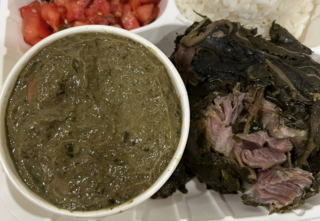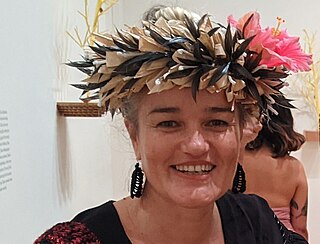
Corned beef, bully beef, or salt beef in some Commonwealth countries, is a salt-cured brisket of beef. The term comes from the treatment of the meat with large-grained rock salt, also called "corns" of salt. Sometimes, sugar and spices are added to corned beef recipes. Corned beef is featured as an ingredient in many cuisines.

Pop art is an art movement that emerged in the United Kingdom and the United States during the mid- to late-1950s. The movement presented a challenge to traditions of fine art by including imagery from popular and mass culture, such as advertising, comic books and mundane mass-produced objects. One of its aims is to use images of popular culture in art, emphasizing the banal or kitschy elements of any culture, most often through the use of irony. It is also associated with the artists' use of mechanical means of reproduction or rendering techniques. In pop art, material is sometimes visually removed from its known context, isolated, or combined with unrelated material.
The traditional culture of Samoa is a communal way of life based on Fa'a Samoa, the unique socio-political culture. In Samoan culture, most activities are done together. The traditional living quarters, or fale (houses), contain no walls and up to 20 people may sleep on the ground in the same fale. During the day, the fale is used for chatting and relaxing. One's family is viewed as an integral part of a person's life. The aiga or extended family lives and works together. Elders in the family are greatly respected and hold the highest status, and this may be seen at a traditional Sunday umu.

Michael Te Rakato Parekōwhai is a New Zealand sculptor and a professor at the University of Auckland's Elam School of Fine Arts. He is of Ngāriki Rotoawe and Ngāti Whakarongo descent and his mother is Pākehā. Parekōwhai was awarded an Arts Foundation of New Zealand Laureate Award in 2001. He represented New Zealand at the 2011 Venice Biennale.

Bully beef is a variety of meat made from finely minced corned beef in a small amount of gelatin. The name "bully beef" likely comes from the French bouilli in Napoleonic times, or possibly from the head of a bull depicted on the popular Hereford brand of canned corned beef. The cans have a distinctive oblong shape. Bully beef and hardtack biscuits were the main field rations of the British Army from the Boer War to the Second World War. It is commonly served sliced in a corned beef sandwich. Potato-based dishes, such as "hash and hotch-potch", in which the potatoes and beef are stewed together, and "corned beef hash", where pre-boiled potatoes and corned beef are mixed with Worcestershire sauce then fried, are also made. Tinned corned beef is also used in France. Some places where British troops were present in the 20th century such as Malta, have adopted bully beef as part of their national cuisine. In February 2009, the British Defence Equipment and Support announced that they would be phasing out bully beef from ration packs as part of the introduction of the new Multi-Climate Ration Packs until this change was reversed due to backlash.
Michael "Michel" Cliff Tuffery is a New Zealand artist of Samoan, Tahitian and Cook Islands descent. He is one of New Zealand's most well known artists and his work is held in many art collections in New Zealand and around the world.

Fatu Akelei Feu'u is a noted Samoan painter from the village of Poutasi in the district of Falealili in Samoa. He has established a reputation as the elder statesman of Pacific art in New Zealand.

Shigeyuki "Yuki" Kihara is an interdisciplinary artist of Japanese and Samoan descent. In 2008, her work was the subject of a solo exhibition at the Metropolitan Museum of Art in New York; it was the first time a New Zealander and the first time a Pacific Islander had a solo show at the institution. Titled Shigeyuki Kihara: Living Photographs, the exhibition opened from 7 October 2008 to 1 February 2009. Kihara's self-portrait photographs in the exhibitions included nudes in poses that portrayed colonial images of Polynesian people as sexual objects. Her exhibition was followed by an acquisition of Kihara's work for the museum's collection.
James Patrick Hanly, generally known as Pat Hanly, was a prolific New Zealand painter. One of his works is a large mural Rainbow Pieces (1971) at Christchurch Town Hall.

The Fray Bentos food brand is associated with tinned processed meat products, originally corned beef and later meat pies. The brand has been sold in the United Kingdom, other European countries, and Australia. Created in the second half of the 19th century, the name is derived from the port of Fray Bentos in Uruguay where the products were originally processed and packaged until the 1960s. The brand is now owned in the UK by Baxters, which manufactures the product range in Scotland. The Campbell Soup Company manufactures and sells Fray Bentos branded steak and kidney pies in Australia.

Lūʻau, Luʻau, Laulau, Lū, Rourou, Rukau, Fāfā, Hāhā, and Palusami are all related dishes found throughout Polynesia based on the use of taro leaves as a primary ingredient. While taro generally is known as a root vegetable for its starchy corms, the leaves are consumed as well. The base recipe is vegetarian. Most often, coconut milk was added, and later meat or seafood. The texture of the dish range from a thick soup to a dense cake.
Niki Hastings-McFall is a New Zealand jeweller and artist of Samoan and Pākehā descent. She has been described by art historian Karen Stevenson as one of the core members of a group of artists of Pasifika descent who brought contemporary Pacific art to 'national prominence and international acceptance'.
Pacific Sisters is a collective of Pacific and Māori artists, performers, fashion designers, jewellers and musicians.

Ani O'Neill is a New Zealand artist of Cook Island and Irish descent. She has been described by art historian Karen Stevenson as one of the core members of a group of artists of Pasifika descent who brought contemporary Pacific art to "national prominence and international acceptance".
Bottled Ocean was an exhibition of work by New Zealand artists of Pacific Island descent that was shown at a number of metropolitan art galleries in New Zealand in 1994–1995. It featured the work artists who have become notable figures in New Zealand and internationally.
Te Moemoea no Iotefa was the first exhibition held in a civic art gallery in New Zealand focused on contemporary Pacific art.
James Earnest Vivieaere, a New Zealand artist of Cook Islands Māori heritage, was born in Waipawa, Hawke’s Bay, New Zealand. He was a well-respected and significant multimedia and installation artist, freelance curator and a passionate advocate for contemporary Pacific art.
Kulimoe'anga Stone Maka, is an interdisciplinary artist of Tongan heritage who lives in Christchurch, New Zealand. In 2011, he was awarded the Emerging Pasifika Artist Award from Creative New Zealand. Maka's work has been exhibited in museums and art galleries in New Zealand, Hawai'i Australia and Tonga. In 2020 he was selected to represent New Zealand at the 22nd Biennale in Sydney.
Andy Leleisi’uao is a New Zealand artist of Samoan heritage known for his modern and post-modern Pacific paintings and art. He was paramount winner at the 26th annual Wallace Art Awards in 2017 and awarded a Senior Pacific Artist Award at the Arts Pasifika Awards in 2021.
Ian David George (1953–2016) was a New Zealand-born Cook Islands senior painter, carver, educator, and curator of Atiu and Rarotonga descent.












